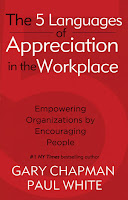AUTHOR: Gary D. Chapman and Paul E. White
PUBLISHER: Chicago, IL: Moody Publishers, 2011.
It seems like "The 5 love languages" first made popular by Dr Gary Chapman has moved from relationships in couples, friends, and loved ones, to relationships in the office. In this latest version, Chapman lets his 5 love languages be applied to the research of his co-author, Paul White about the workplace. The key thesis of the book is described by the authors as follows:
"We believe that people in the workplace (whether a paid or volunteer position) need to feel appreciation in order for them to enjoy the job, do their best work, and continue working over the long haul." (27)
Instead of 'love' which brings connotations of office romance, or weirdness to a supposedly businesslike office environment, the terminology has been changed to '5 languages of appreciation.' The key ingredient in the book is 'appreciation.' Briefly, the five languages are:
- Words of Affirmation
- Quality Time
- Acts of Service
- Tangible Gifts
- Physical Touch
The book is structured in four sections. In Section One, the foundations basically consist of an explanation of the 'MBA' (Motivation By Appreciation). It makes a few observations as follows:
- "The number one factor in job satisfaction is not the amount of pay but whether or not the individual feels appreciated and valued for the work they do." (13)
- That every individual has a primary, a secondary, as well as a tertiary language of appreciation
- "Each of us wants to know that what we are doing matters." (22)
- "For recognition and appreciation to be effective, it must be individualized and delivered personally." (23)
- "appreciation needs to be viewed as valuable to the recipient in order to have an impact." (23)
- "Employees are more likely to burn out when they do not feel appreciated or emotionally supported by their supervisors." (23)
- "When leaders actively pursue communicating appreciation to their team members, the whole work culture improves." (25)
- "Discouragement
- Burnout
- Feeling overwhelmed
- losing the positive corporate culture built over the years
- how to encourage employees with few financial resources available. " (34)
The key finding in the research is:
"Going to work in an environment where there is a sense of appreciation for what we contribute is more enjoyable than doing the same tasks (for the same money) and not feeling valued by those around us." (42)
The authors then describe in great detail about each of the five MBA languages in Section Two. In 'Words of affirmation,' one demonstrates appreciation through praise for accomplishments, affirmation of character, understanding personality traits, and knowing how and when to affirm. In 'Quality Time,' one demonstrates MBA through precise listening, really value employee comments, or simply spending meaningful time at various activities like an occasional coffee chat, an outing, dinner with the family, and playing hard as well as working hard. In 'Acts of Service,' one builds community through teamwork, volunteering to help others while maintaining one's responsibility well, having a positive attitude, and to provide a positive part in culture building. In 'Tangible Gifts,' one needs to identify what is the right gift, and who the right person is. One needs to know what gifts are valued and that gifts need to be thoughtful. Of course, it is also important to know that certain other gifts may have negative connotations. It can also be in kind like time off, or volunteering. In 'Physical Touch,' it needs to be done in a culturally acceptable and socially appropriate manner, like a handshake, a good pat on the back, or a nice high-five. At all times, be sensitive about sexual harassment matters. If in doubt, always ask.
Section Three describes the inventory list of questions and procedures to discover the MBA languages. Section Four brings everything together by listing some common obstacles to a successful MBA exercise. I like the top 10 easiest ways to do the MBA.
- Give a verbal compliment
- Write an email to encourage
- Stop by to see how a colleague is doing
- Do something WITH your co-worker
- Do a small task for someone spontaneously
- Stop by anytime to ask if they need help
- Buy them coffee or snacks
- Get a magazine for them to read
- Give a high-five after every milestone
- Warmly greet one another.
My Comments
This is overall a very positive book. I am surprised by the simplicity and effectiveness of the concept. I particularly like the way the authors make a distinction between 'recognition' and 'appreciation.'
- Recognition emphasizes on performance; while MBA is on the value of the employee
- Recognition benefits only a few; MBA can reach many
- Recognition is more top-down; MBA can be from any direction
- Recognition can be costly; MBA is affordable
The authors are also very thoughtful to include the non-profit sections of society. This is most important as appreciation in such organizations tend to presume that people CHOOSES to be in the organization in the first place, as they are not usually paid. I will even say that appreciation for the non-profit workplace is even more crucial. The biggest costs to such organizations is again, staff turnover. Better to invest well through appreciation right from the start. I too like the appendices which contains lots of resources and helps.
Perhaps, in closing, the biggest risk of MBA is NOT to do any appreciation exercise. This I believe is the most important idea to take home. Great book.
Rating: 4.5 stars of 5.
conrade
This book is supplied to me free, courtesy of Moody Publishers and NetGalley without any obligation for a positive review. The comments above are freely mine.

No comments:
Post a Comment